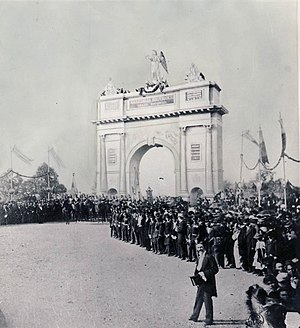
Back حرب الاستقلال الرومانية Arabic رومانینین باغیمسیزلیغینی قازانماسی AZB Вайна за незалежнасць Румыніі (1877-1878) Byelorussian Румънска война за независимост Bulgarian Guerra d'independència de Romania Catalan Den rumænske selvstændighedskrig Danish جنگ یکپارچگی رومانی Persian Guerre d'indépendance de la Roumanie French Guerra romanesa de independencia Galician Ռումինիայի անկախության պատերազմ Armenian
| Romanian War of Independence | |||||||||
|---|---|---|---|---|---|---|---|---|---|
| Part of the Russo-Turkish War of 1877–78 | |||||||||
 Romanian troops returning to Bucharest after the war, 8 October 1878. | |||||||||
| |||||||||
| Belligerents | |||||||||
|
|
| ||||||||
| Commanders and leaders | |||||||||
|
|
| ||||||||
| Strength | |||||||||
|
190 cannons 500 cannons[2] |
210 cannons | ||||||||
| Casualties and losses | |||||||||
|
|
(during the entire Russo-Turkish War)[7] 2 river monitors sunk[8][9] | ||||||||
| History of Romania |
|---|
 |
|
|
The Romanian War of Independence is the name used in Romanian historiography to refer to the Russo-Turkish War (1877–78), following which Romania, fighting on the Russian side, gained independence from the Ottoman Empire. On April 16 [O.S. April 4] 1877, Romania and the Russian Empire signed a treaty at Bucharest under which Russian troops were allowed to pass through Romanian territory, with the condition that Russia respected the integrity of Romania. Consequently, the mobilization of the Romanian troops also began, and around 114,000 soldiers [10] were massed in the south of the country to defend against an eventual attack of the Ottoman forces from south of the Danube. On April 24 [O.S. April 12] 1877, Russia declared war on the Ottoman Empire and its troops entered Romania through the newly built Eiffel Bridge, on their way to the Ottoman Empire. Due to great losses, the Russian Empire asked Romania to intervene. On July 24 [O.S. July 12] 1877, the first Romanian Army units crossed the Danube and joined forces with the Russian Army.[11]
- ^ "ARMATA ROMANA IN RAZBOIUL DE INDEPENDENTA AL ROMANIEI (1877-1878)".
- ^ Мерников А. Г., Спектор А. А. Всемирная история войн. — Минск: 2005. — С. 376.
- ^ Istoria Militară a Poporului Român (The Military History of the Romanian People), Centrul de Studii și Cercetări de Istorie și Teorie Militară, Editura Militară, București, 1987 (in Romanian)
- ^ Scafes, Cornel, et al., Armata Romania in Razvoiul de Independenta 1877–1878 (The Romanian Army in the War of Independence 1877–1878). Bucuresti, Editura Sigma, 2002, p. 149 (Romence)
- ^ Урланис Б. Ц. Войны и народонаселение Европы. — М.: 1960.
- ^ Мерников А. Г., Спектор А. А. (2005). Всемирная история войн. Minsk: Харвест. ISBN 985-13-2607-0.
- ^ Kaminskii, L. S., și Novoselskii, S. A., Poteri v proșlîh voinah (Victimele războaielor trecute). Medgiz, Moscova, 1947, pp. 36, 37
- ^ Cristian Crăciunoiu, Romanian Navy Torpedo Boats, p. 19
- ^ Nicolae Petrescu, M. Drăghiescu, Istoricul principalelor puncte pe Dunăre de la gura Tisei până la Mare şi pe coastele mării de la Varna la Odessa, p. 160 (in Romanian)
- ^ "ARMATA ROMANA IN RAZBOIUL DE INDEPENDENTA AL ROMANIEI (1877-1878)".
- ^ "Demersuri româno-ruse privind implicarea armatei române la sud de Dunăre". Archived from the original on 2020-07-20. Retrieved 2018-10-14.